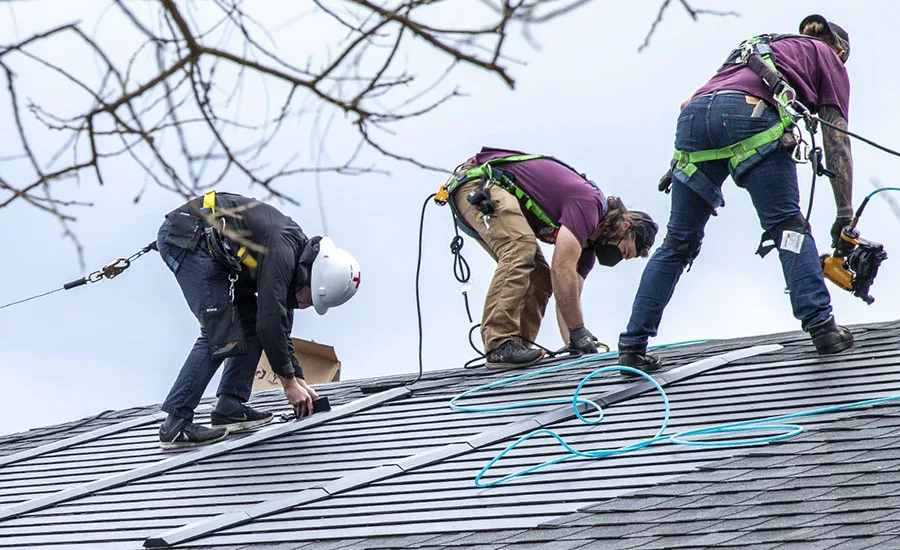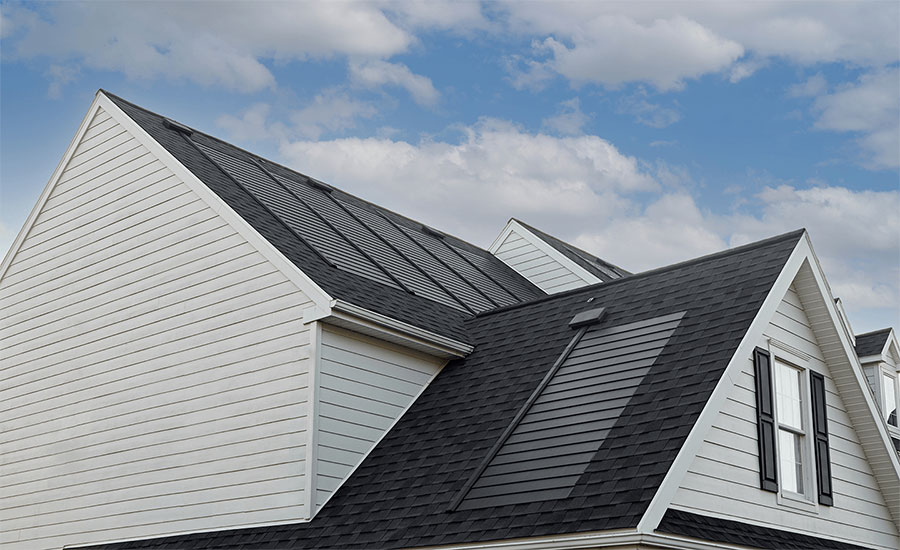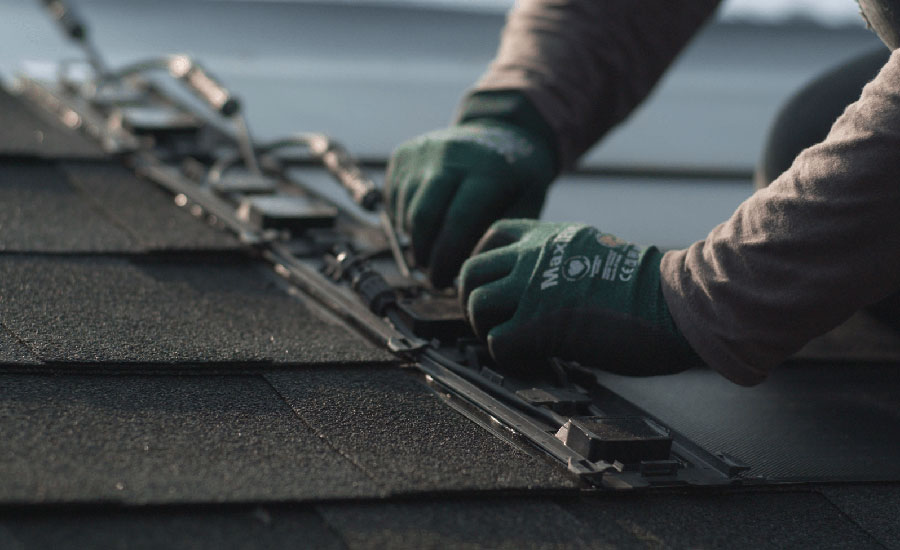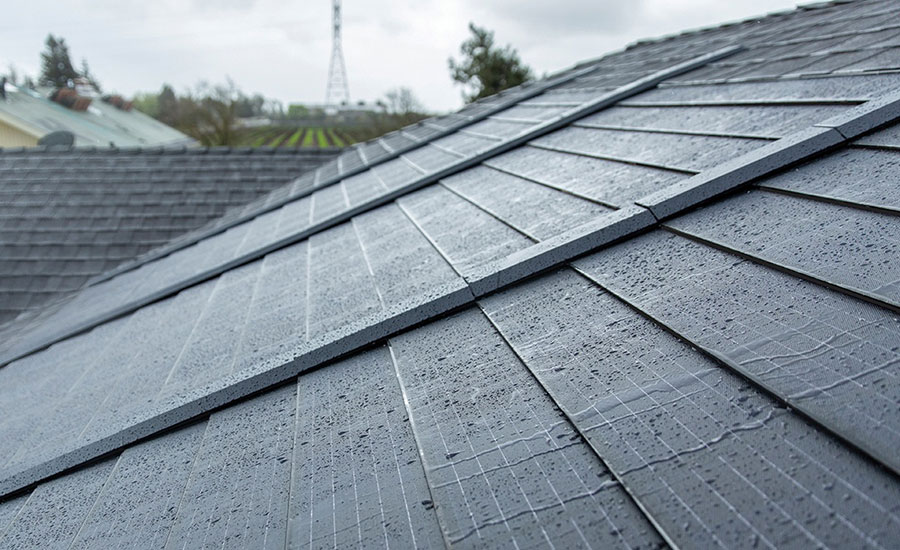Sponsored by GAF Energy
Roofing Contractor's 2022 Solar Special Section
Innovation, incentives and inclement weather create new opportunities for roofing contractors entering the solar market.

Roofing contractors installing GAF Energy's Timberline Solar roof. Photos courtesy of GAF Energy.
There are few emerging trends in the roofing space hotter than solar as the final quarter of 2022 settles in. Whether it’s through innovative product launches, groundbreaking research, or proving its potential for resiliency in both fiscal terms and physical reality, solar is driving a lot of interest in residential and commercial roofing markets around the country.
And roofing contractors are paying attention. With new federal and state policies extending solar investment tax credits for at least another decade, the potential business opportunity is too great for many to let pass by. According to survey data compiled in RC’s 2022 State of the Industry Report, roughly 56% of residential contractors indicated their solar sales increased last year, and nearly half (47%) expected another increase by the end of 2022.
The report also signaled tremendous gains in the commercial roofing sector. According to the data, 64% of commercial contractors reported an increase in last year’s solar sales, while more than half (51%) anticipated a further increase in 2022. Contrast that with the current use of solar roofing in the commercial space and a clearer picture of the market potential appears. Just 17% of roofing contractors said they were involved with solar roofing products, and it accounted for just 2% of their overall annual sales revenue. Yet 100% of the same respondents indicated they expected solar sales to remain the same or increase (35%) this year – the only product category not expected to see a decrease at all.
So it’s not surprising to see forward-thinking roofing contractors in typical and atypical markets take the plunge into solar roofing.
“We wanted to provide an option for our customers to reduce their carbon footprint as well as provide a clean energy source that affords them the opportunity to generate a return on investment with regard to their roof system,” said Adam Resnick, owner of Resnick Roofing & Contracting in Pittsburgh.
Resnick was among the first roofers in the country to install GAF Energy’s Timberline Solar shingle when it became available earlier this year. The groundbreaking product continues to win awards and accolades both within and outside the roofing trade as it approaches a full year on the market. It also became a hit with homeowners due to its cost-saving potential and aesthetics, said Resnick, who believes adding the product line has changed his business.
“Outside of now being able to provide our customers with a roofing solution that produces clean energy, our average roofing job size, in terms of contract value, has increased by approximately 15%,” Resnick said.
While Pennsylvania may not be the typical market geared for solar, the market penetration there speaks to what solar roofing’s overall viability can be regardless of region. The opportunity was too good to led slide by for the team at Austin Roofing and Construction in Austin, Texas. Founded by Tim Bowen, a third-generation roofer, the residential and commercial contractor began installing solar products in early 2022.
They too found success selling and integrating the Timberline Solar shingle into their service offerings. Key difference makers were the cost differential to other solar systems, rising energy prices and a growing demand for more energy efficiency among both homeowners and facility operators, officials said.
Texas residents also have keen memories when it comes to unpredictable weather.
“We are able to help people generate on-site electricity, which helps us move toward sustainable energy as a community," said Christine Bowen, Austin Roofing’s chief visionary officer. “Clients love (solar roofs), we have a lot of sun and most everyone still remembers last year’s ‘Snowpocalypse.’”
Bowen is also optimistic about a bright future for solar roofing due to continued advances in technology and new incentives from the recently passed Biden climate change bill. Proponents believe it will make solar more affordable to home and business owners at a time when electricity rates approach record highs in many regions of the U.S.

“Outside of now being able to provide our customers with a roofing solution that produces clean energy, our average roofing job size, in terms of contract value, has increased by approximately 15%,” said Adam Resnick, owner of Resnick Roofing & Contracting.
SOLAR STIMULUS
The Inflation Reduction Act (IRA) has approximately $370 billion earmarked for clean energy and climate initiatives. With this funding, construction businesses can move forward with efforts like carbon emission reduction, carbon capture, and perhaps most importantly for roofing companies, solar.
The IRA will likely boost consumer interest even further in solar roofing and storage batteries thanks to the incentives it provides, so contractors should become familiar with them if they want to participate in the solar market.
The IRA includes the “Residential Clean Energy Credit” (formerly the Investment Tax Credit), which provides a 30% tax credit on federal taxes for the installation of solar heating, electricity generation and other solar products. This is retroactive to the beginning of 2022.
The 30% credit will be available until Dec. 31, 2032, when it will drop to 23% until 2033, then 22% in 2034, then disappears in 2035 unless it’s renewed. The solar tax credit covers: solar photovoltaic panels; contractor labor for onsite preparation, assembly, or original installation; permitting, inspection and developer fees; any equipment needed for the solar system to operate, like wiring; storage batteries; and sales tax on certain expenses.
There is no dollar limit to the eligible expenses, so customers aren’t locked into spending certain amounts to gain the credit. If you work in a state that offers a credit, check to see if your state will allow customers to reduce their state credit if they use the federal credit.
Trent Cotney, partner and construction team co-leader at Adams and Reese, praised the IRA for its ability to help the environment, but said contractors will need to understand what solar can offer their customers before taking advantage of it.
“Part of it is getting with your sales people to understand what they can pitch and how it ties in with what this bill offers,” he said.
The bill will create a slew of public and federal projects as well, so contractors should monitor those projects and bid on them accordingly, says Cotney.
“There’s going to be a lot of improvements from a construction standpoint that I anticipate will come out both from the federal and state and local framework,” he said.
On the supply side, the law includes over $60 billion to on-shore clean energy manufacturing in the U.S. across the clean energy and transportation supply chain. This includes $30 billion to accelerate the U.S. manufacturing of solar panels, wind turbines and more.

The IRA includes the “Residential Clean Energy Credit,” which provides a 30% tax credit on federal taxes for the installation of solar heating, electricity generation and other solar products.
IRA’S IMPACT ON LABOR
As much as the law will support clean energy opportunities, there are some aspects that affect labor costs and practices. The Investment Tax Credit for commercial building solar, as well as the Production Tax Credit for solar farms, have labor requirements.
The IRA provides bonus tax credits for taxpayers who meet prevailing wage and apprenticeship rules for their projects. According to the National Law Review, for a 30% Investment Tax Credit, projects must pay prevailing wages during construction and the first five years of operation. For the Production Tax Credit’s 2.6 cents per kilowatt hours credit, prevailing wages must be paid in the first 10 years.
Along with prevailing wages, the IRA mandates the use of apprentices in the U.S. Department of Labor’s Registered Apprenticeship program. Projects must have a set percentage of hours worked by apprentices. The wage and apprenticeship requirements apply to employees of contractors and subcontractors as well as the company.
According to Cotney, there are also incentives available to builders of single-family homes and multi-family buildings through the Energy Efficient New Home Tax Credit. Extended to Dec. 31, 2032, this offers credits for meeting Energy Star requirements or the Department of Energy’s “Zero Energy Ready Homes” program. However, prevailing wage requirements must be met for multi-family buildings.
Cotney said wage requirements are based on the Davis-Bacon Related Acts, meaning workers must be paid at prevailing wage rates – typically based on what unions pay in the area. He said additional paperwork is in the future for contractors and subcontractors as well due to certified payroll requirements.
“Primarily, this has been in the federal sphere in the past, but this is going to be required to be used for any of these clean energy-type construction projects they’re doing in the private realm,” Cotney said.
Violations of the wage and apprenticeship rules will result in a $5,000 penalty per covered employee related to the underpayments. If it’s found to be intentional, it doubles to $10,000.
Facilities with a maximum net output of less than 1 megawatts of AC power will automatically qualify for the tax credit multiplier without having to satisfy the requirements. Residential solar has no labor requirements.

While residential solar doesn't have labor requirements in the IRA, commercial projects may need to abide by wage and apprenticeship rules.
INVENTIVE CONTRACTORS
Aside from diversifying, solar gives contractors the opportunity to provide customers with self-sustaining technology. This was highlighted most recently with Hurricane Ian, where Florida communities and businesses with solar capabilities still had power after the Category 4 storm.
Advanced Roofing Inc. in Fort Lauderdale, Fla., has worked with solar for years. When Hurricane Ian thrashed Florida, the commercial roofing company checked on its various solar customers to find that most of them only received minor damage.
“In Florida with insurance, there were big articles before the storm about insurance companies not wanting to insure building and housing with solar,” said Rob Kornahrens, CEO of Advanced Roofing Inc. “We have real-time data that says hey, it does work if it’s installed properly.”
In addition to installing solar, the company has its hand in manufacturing it as well. Kornahrens is the CEO of Power Panel, a company revolutionizing solar technology by combining PV electrical production with solar thermal capture to maximize both energy streams. Designed by Garth Schultz, president of Power Panel, the module can produce solar hot water and low-cost electricity. Heating a 50 gallon tank of water a day with Power Panel costs 21% less and occupies 50% less space than traditional PV.
Power Panel’s technology is being utilized nationally and internationally, from low-income housing in Cleveland to sending units to Ukraine. Its stand-alone generator technology, Gen-2-0, was successfully deployed to help people in Puerto Rico after Hurricane Maria in 2018.
Kornahrens said they’ve been working with companies in China and Brazil but the IRA has been a game-changer. Right now the company has small-scale manufacturing capabilities, but through loans and grants, including those from the IRA, it is looking to scale its production in 2024.
“We’re really starting to commercialize it,” said Kornahrens. “Now with the incentives coming back for 10 years at 30%, we’re re-focusing on the U.S. market.”
Looking for a reprint of this article?
From high-res PDFs to custom plaques, order your copy today!







